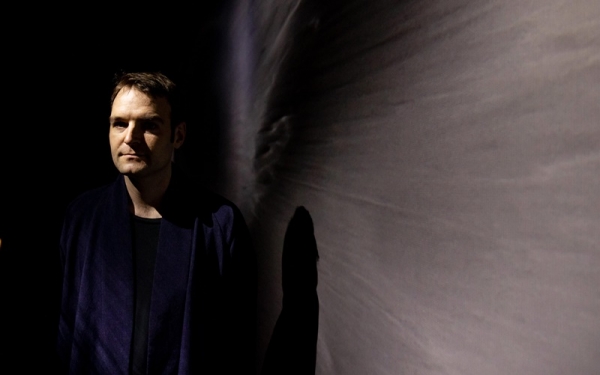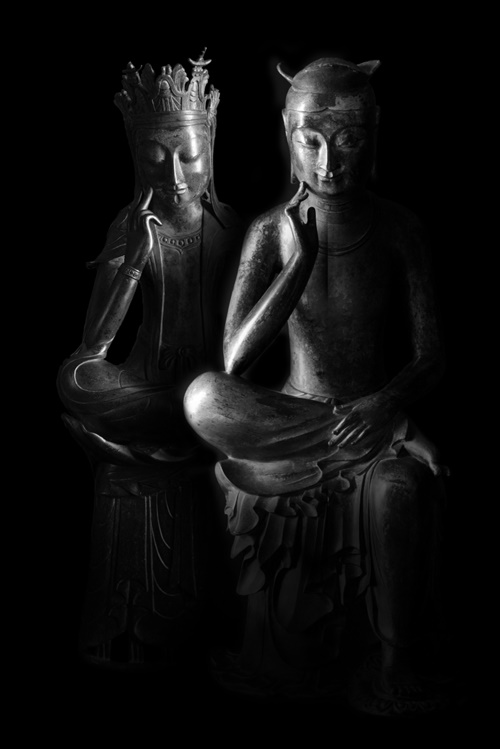
French video artist Jean Julien Pous is exhibiting two media works and a photo series at the permanent exhibition "Room of Quiet Contemplation," which opened on Nov. 12 at the National Museum of Korea.
The exhibition displays Bangasayusang, or two gilt-bronze pensive bodhisattva statues designated National Treasures originating from the Three Kingdoms era (57 B.C.-668 A.D.), with one made in the late sixth century and the other in the early seventh. The room displays just these two relics as the museum aims to make the statues its representative brand just like the "Mona Lisa" of the Louvre Museum in Paris.
The two media works by Pous are "Cycle" and "Lighthouse." He also took the photos in the exhibition poster and pamphlet.
Korea.net on Dec. 6 interviewed Pous at the Seoul museum on how he created video and photo works on leading Korean cultural assets.
-How did you get involved with this exhibition?
I was staying in France in July when the National Museum of Korea asked me to participate in a media art project. I hesitated when I heard that it was about the pensive bodhisattva statues because I didn't know much about the relevant field. Yet I accepted the offer with the expectation of a good opportunity. I gained basic knowledge on the project thanks to a French friend with a Ph.D. in Buddhist philosophy who explained to me fundamental Buddhist concepts and the pensive bodhisattva in an easily understandable manner.
- Describe the process of carrying out the video and photo projects.
The project took four months this year from August to November. In the early stage, I discussed with the museum the video's theme and began making the video after the theme was finalized. Filming long hours was difficult, as the museum storage where the relics are preserved has strictly observed hours. I thus filmed the relics for an hour or two and used them in the video.

- How did you feel when filming the statues?
Both statues were laid on the floor, so my first impression was like looking at little children. As I filmed the photos, I felt subtle differences depending on the angle. When I filmed the statues from bottom to top, I got a human-like feeling from their smiles. When I looked at them from above, they looked like Buddha, which transcends everything in the world. It was similar to how the smile on da Vinci's "Mona Lisa" looks different every time you look at it. The feelings evoked by the two bodhisattvas were also different. The one from the late sixth century felt a bit masculine while the other from the early seventh felt round and feminine.
- What was your focus when creating the two media artworks?
I made "Lighthouse," which is displayed on the outer wall of the exhibition, with the intent of forming a relationship between visitors and the two statues that stand alone. I wanted to express lost souls finding hope as they meet the pensive bodhisattvas. The statues are like a lighthouse that guides people in a dark night. As seen in the exhibition trailer, I made them so that the statue is only partially revealed. As you walk along the dark corridor, you see "Cycle" on the left, which shows the connection between Buddhism and the change of water's form from liquid, solid, and gas. I made the video dark so that visitors can get used to the darkness, empty their minds and focus on the pensive bodhisattvas. I used photos I took of the Pyrenees ridges in southern France to express surrealism.
- Is this your first project with a Korean museum?
No, my first project with a Korean museum was back in 2017, when I made a music video with the National Hangeul Museum for an exhibition. Last year, I worked with the National Museum of Korea by creating the media artwork "Winter Time" for its exhibition "After Every Winter Comes Spring." I also created one released to the public on Nov. 24 at the Room of Buddhist Temples of the Silla Art Gallery at Gyeongju National Museum.
- What was the most memorable aspect of working with a Korean museum?
My first thought was that Korea is culturally open. It's amazing how they trust a foreigner with an exhibition about their own culture. It was a great honor to see as I worked so closely with precious artifacts that cannot be seen even at the Louvre in France. I am grateful for the opportunity to see a precious cultural property that non-Koreans cannot easily access.
- Any concluding message for Korea.net's readers?
Since I first came to Korea in 2008, I didn't have much difficulty in the country whenever I struggled because of Korea's unexpected and unique jeong (a broad Korean concept loosely defined as "affection" or "feeling of bond"). I continue to create art as I'm drawn to Korea's unique charms. Though Korea is a small country, it has a lot of cultures to explore. I hope to expand my range of art while in Korea.


